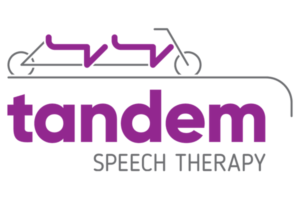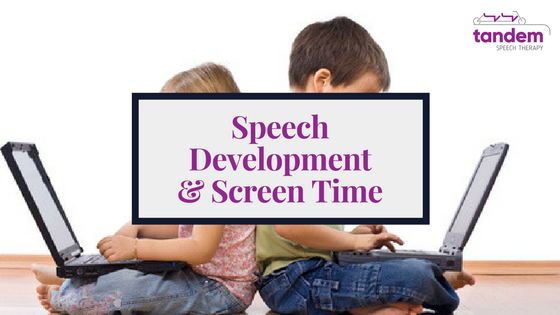In many workshops I have given recently, the topic of screen time has come up. We live in an ever-growing, technological world and society. We cannot escape screen time. But, what impact does it have on our children? Before we delve into the research, it’s important to answer the question, “What is screen time?” Screen time refers to any activities that your child engages in with a screen turned on and in front of their face. This includes opportunities that are both direct and indirect. Indirect screen time occurs when a screen is turned on, but your child is not directly “watching,” for example the tv is on for you to listen to the news but no one is sitting down in front of it. Screens include a television, movie theater screen, smartphone, tablet, computer, hand-held video game device, DVD player in the car, or anything else with a screen and moving pictures. It doesn’t matter if your child is watching an educational video or playing a game, screen time is screen time. Screen time is sedentary activity, meaning you are physically inactive while sitting down.
What does the research say about speech development and screen time?
Children learn to talk and communicate through interactions with other people. The first several years of life are crucial for your child’s language development. It is when their brain is the most receptive to learning language and is building communication pathways that will be with them for the rest of their lives. That is why you often hear a young child’s brain referred to a sponge. They soak up tons of information by watching and listening to you during your interactions. Once that window closes, it is much more difficult for someone to learn and develop language skills. That’s why it’s harder for you to learn a foreign language as an adult. Every minute that your child spends in front of a screen is one fewer minute that he/she could spend learning from your interactions with him or practicing her engagement with you. Screen time takes away from time that could (and should) be spent on person-to-person interactions. The Center on the Developing Brain at Harvard University describes this as “Serve and Return.” Preliminary research conducted by Dr. Catherine Birken at the Hospital for Sick Children in Toronto, and published in May 2017, indicated that by the time children reached their 18-month well visit checkups, 20 percent of the children used mobile devices for 28 minutes on average each day. They found children who spent more time with hand-held screens were more likely to exhibit signs of a delay in expressive speech — how children use their sounds and words, and how they put their words together to communicate. Additionally, each additional 30 minutes of hand-held screen time was linked to a 49 percent increased risk for an expressive language speech delay. While the study by Dr. Birken does not prove cause and effect, it does highlight the fact that exposing children to too much screen time will impact their expressive speech. Another study published by Chonchaiya and Pruksananonda found that children who began watching television before 12 months and who watched more than 2 hours of TV per day were six times more likely to have language delays!
In October 2016, the AAP released a new “Media Use Policy” and outlined updated recommendations for screen time in young children.
Their recommendations are: Children younger than 18 months of age: Avoid the use of any screen media except video chatting (with grandparents, for example). Children ages 18 months to 24 months: Introduce high-quality programs or apps, but do it with your children to create a dialog about what they are seeing and how it relates to the world around them. Children ages 2 to 5 years: Limit screen time to one hour a day of high-quality programs that you view with your children. Children ages 6 years and older: Place consistent limits on time spent using media, the types of media and make sure that the use of media does not take the place of sleeping, exercise, and other healthy behaviors. The new policy does not set a specific limit for those ages six years on up but recognizes that sleep and exercise should be the priority. It also talks about the importance of decreasing screen time and how you can accomplish this: sleeping more, doing hobbies, reading, being with friends, doing sports or anything else you want to add. Additionally, the policy recommends designating media-free times together such as during dinner or while driving as well as media-free locations at home such as bedrooms.
What does the American Academy of Pediatrics recommend?
What are some good alternatives to screen time?
There are MANY alternatives to screen time that are much better for your child’s development and will help you build a better relationship with your child as well. You may have seen the movement for a #devicefreedinner put out by an organization called Common Sense Media. They are a fantastic resource for helping you find high-quality programs when it’s appropriate for your child. It is important for you to put away your screens when you interact with your child. If you’re struggling with ideas then think about my Playing With Purpose blog series. Or try these activities instead:
- Sing songs or read a book
- Play with your child’s favorite toy
- Color a picture or make a craft project
- Play in the yard, ride bikes, go for a walk or take your child to the park
- Go for a car ride and talk about what you see
- Go to the library and look for books on a topic that interests your child
- Play a board game
- Call up some friends and have a play date
- Cook something in the kitchen together
- Talk to each other
Conclusion and My Thoughts
I should tell you that I use an iPad with kids in my private, pediatric speech therapy practice. There are many, high-quality apps created by speech-language pathologists like myself. I think the key here is the fact that I am facilitating the experience. The child is never engaged one-on-one with the iPad. The child is interacting one-on-one with me, and the iPad is merely a teaching tool. I would be lying if I didn’t agree with the fact that screens are engaging for young children and engagement is a foundation for building language skills. While I would always prefer toys or books for providing language intervention, the reality is that I have to meet kids where they are. When I use my tablet in therapy, I am always talking with the children, and we are using the tablet together to build on or learn a skill. My professional opinion is that you, as a parent or caregiver, should significantly limit the screen time you provide your child. In fact, I think we should probably all significantly reduce our screen time, but I am not sure that is realistic given our technologically-based society. This is particularly true if your child has a language delay. In that case, then I believe your child should have no screen time, at least for a little while. Try cutting out screen time with your child entirely (if you can) for 30 days. See if you notice any changes in their communication. After that, you can reintroduce short amounts of screen time to see if there are any adverse effects. Remember every minute that your child spends in front of a screen is one fewer minute that he/she could spend learning from your interactions or practicing back-and-forth engagement with you.Playing With Purpose is a great alternative to screen time. Want to learn more?
Start Playing With Purpose
Learn how to purposefully and intentionally interact with your child during play and help them increase opportunities for speech and language development with our Playing with Purpose book!











